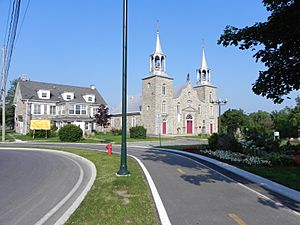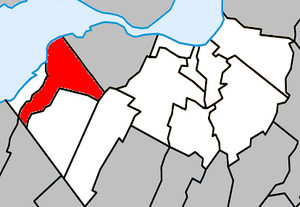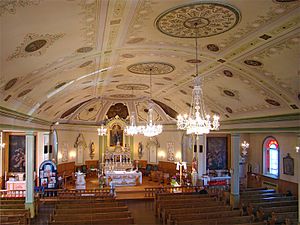Châteauguay facts for kids
Quick facts for kids
Châteauguay
|
|||
|---|---|---|---|
|
City
|
|||
 |
|||
|
|||
| Motto(s):
Unita Fortior
(Latin: "Stronger when United") |
|||

Location within Roussillon RCM
|
|||
| Lua error in Module:Location_map at line 416: Malformed coordinates value. | |||
| Country | |||
| Province | |||
| Region | Montérégie | ||
| RCM | Roussillon | ||
| Constituted | November 3, 1975 | ||
| Area | |||
| • City | 46.50 km2 (17.95 sq mi) | ||
| • Land | 34.31 km2 (13.25 sq mi) | ||
| • Urban | 50.48 km2 (19.49 sq mi) | ||
| Population
(2021)
|
|||
| • City | 50,815 | ||
| • Density | 1,481.2/km2 (3,836/sq mi) | ||
| • Urban | 75,891 | ||
| • Urban density | 1,503.4/km2 (3,894/sq mi) | ||
| • Pop 2016-2021 | |||
| • Dwellings | 20,412 | ||
| Time zone | UTC−5 (EST) | ||
| • Summer (DST) | UTC−4 (EDT) | ||
| Postal code(s) |
J6J, J6K
|
||
| Area code(s) | 450 and 579 | ||
| Highways |
|||
Châteauguay is a city in southwestern Quebec, Canada. It's like a neighbor to Montreal, located on the Châteauguay River and Lac St-Louis. Lac St-Louis is actually part of the big St. Lawrence River. In 2021, about 50,815 people lived in Châteauguay. The larger area around it, called the population centre, had about 75,891 people.
Contents
History of Châteauguay
The land where Châteauguay now stands was first given to Charles Lemoyne by the governor of New France (which was what Canada was called when France owned it). This happened so a special land system called a seigneurie could be set up. Later, in 1706, Zacharie Robutel de la Noue took over the seigneurie.
In 1763, France gave up its control over Canada, and Châteauguay became part of the British lands. A few years later, in 1765, Marguerite d'Youville bought the seigneurie. She was a founder of a religious group called the Grey Nuns. Ten years after that, in 1775, construction began on the Church of Saint-Joachim, which is still there today.
Why was Châteauguay important in the War of 1812?
Châteauguay played a big role in the War of 1812. This war was fought between the United States and Britain. In 1812, the United States declared war on Britain. Châteauguay was a good spot to place soldiers to protect Montreal from an invasion.
On October 26, 1813, a major battle happened here called the Battle of the Châteauguay. Lieutenant Colonel Charles de Salaberry, with only about 400 soldiers (mostly French-Canadians and 170 Kahnawake Mohawk warriors), stopped a much larger American force of 4,000 troops. This victory helped protect Montreal. Another American attack towards Montreal was also stopped soon after at Crysler's Farm.
What happened during the Lower Canada Rebellion?
Châteauguay was also involved in the Lower Canada Rebellion in 1838. This was a time when some people in Quebec, called the Patriotes, rebelled against the government. Some of their leaders, like François-Maurice Lepailleur, Joseph Duquet, and Joseph-Narcisse Cardinal, were arrested in Châteauguay. Duquet and Cardinal were later put to death and are remembered with a monument in Montreal.
The village of Châteauguay officially started in 1855. This happened after the old seigneurie land system was ended in Quebec. Over time, Châteauguay grew by adding two nearby areas: Châteauguay-Heights in 1968 and Châteauguay-Centre in 1975. In 1982, the city became part of the Roussillon Regional County Municipality.
People of Châteauguay: Demographics
|
|||||||||||||||||||||||||||
In the 2021 Census, Châteauguay had a population of 50,815 people. This was a 6.1% increase from its population in 2016. The city covers a land area of about 34.31 square kilometers.
What languages are spoken in Châteauguay?
Châteauguay has always had a good number of English speakers in the Montérégie region. According to the 2021 census:
- About 56% of people mainly speak French at home.
- About 29% mainly speak English at home.
- About 2% mainly speak Spanish at home.
When it comes to people's first language (their mother tongue):
- 53.4% speak French.
- 25.1% speak English.
- Other common first languages include Spanish (3.1%), Russian (2.0%), Arabic (1.9%), and Romanian (1.2%).
- Some people (3.0%) have both French and English as their mother tongues.
What are the different cultures and backgrounds in Châteauguay?
Châteauguay is a diverse city. Most residents (74.3%) are of White/European background. About 2.7% are Indigenous people. The remaining 23.0% are from various visible minority groups. The largest visible minority groups include Black people (11.5%), Arab (3.3%), Latin American (3.1%), and South Asian (1.5%). Châteauguay has the highest percentage of Black residents in Quebec outside of Montreal Island.
City Services and Transportation
How does public safety work in Châteauguay?
The Châteauguay Police force has over 130 police officers. They work to prevent crime, investigate cases, and patrol the city. They also help with many community activities. The police force used to only work within Châteauguay. However, from 2002 to 2007, they started helping nearby cities like Léry, Mercier, Beauharnois, and Saint-Isidore. Mercier later started its own police system in 2019.
What about electricity in Châteauguay?
Since 1984, Châteauguay has been home to a very large power station. It's called an HVDC-back-to-back station. This station helps manage and transmit a lot of electricity, up to 1000 megawatts!
How do people get around Châteauguay?
Public transportation in Châteauguay is managed by CITSO. They have bus routes that go around Châteauguay and connect to the Angrignon metro station in Montreal. During busy times, there are special express buses that go directly to downtown Montreal. There's even a special bus lane on Highway 138 to make the trip faster.
Châteauguay also offers a Taxi-Bus service. If you live in an area where the regular bus doesn't go, you can use this service. CITSO pays for a taxi to take you to a bus stop or a specific spot near your home.
Education in Châteauguay
Most schools in Châteauguay are public schools. There is one semi-private school called Collège Héritage. Here is a list of some of the schools in Châteauguay:
- Collège Héritage - A semi-private high school for French-speaking students. It also has elementary school students in grades 5 and 6.
- Howard S. Billings Regional High School - A high school for English-speaking students.
- Louis-Philippe-Paré (L.P.P.) - A high school for French-speaking students.
- Gabrielle-Roy - A middle school for French-speaking students.
- Centennial Park Elementary (CPS) - An elementary school for English-speaking students.
- St-Jude - An elementary school for French-speaking students.
- Mary Gardner - An elementary school for English-speaking students.
- École de La Rive - An elementary school for French-speaking students.
- Laberge - An elementary school for French-speaking students.
- Harmony School - An elementary school for English-speaking students.
- St-Jean-Baptiste - An elementary school for French-speaking students.
- St. Willibrord - An elementary school for English-speaking students.
- Gérin-Lajoie - An elementary school for French-speaking students.
- Notre-Dame-de-l'Assomption - An elementary school for French-speaking students.
- Marguerite-Bourgeoys - A middle school for French-speaking students.
- Trois-Sources - An elementary school for French-speaking students.
- Marc-André Fortier - An elementary school for French-speaking students.
The NOVA Career Centre for adult students is now located next to Howard S. Billings. It used to be inside the school building.
In the 1980s, three English elementary schools in Châteauguay became French schools because the number of French-speaking students grew:
- St-Paul School: This was an English Catholic elementary school. It was later renamed École des Trois Sources.
- Julius Richardson: As the oldest English elementary school in Châteauguay, it operated under the Chateauguay Valley School Board until its closure in the early 1980s. The building was subsequently ceded to the Commission Scolaire de Châteauguay and repurposed, first housing the Centre l'Accore d'Abottsford and later functioning as an adult education centre.
- Robert A. Jobber: This was the last English school to close, in 1988. It became École Gabrielle Roy. To remember Robert A. Jobber, the gym at Centennial Park school was named in his honor.
Media in Châteauguay
The local newspaper for Châteauguay is called Le Soleil (which means The Sun). Another newspaper, Châteauguay Express, stopped publishing in 2014.
Famous People from Châteauguay
Many interesting people have connections to Châteauguay:
- IMA - A pop singer.
- Vanessa Gilles - A soccer player for the Canadian national team.
- Rick Genest (1985–2018) - Also known as Zombie Boy, he was a famous fashion model and entertainer.
- Corey Crawford (born 1984) - A hockey goalie who played for the Chicago Blackhawks.
- Kim St-Pierre - A goaltender for Team Canada's women's hockey team. She won three gold medals at the Winter Olympics (2002, 2006, 2010).
- Pierre Falardeau - The creator of the Elvis Gratton movie series. He was born in Châteauguay, and parts of his movie Elvis Gratton, Le King des Kings were filmed there.
- Chester Brown - An award-winning cartoonist who grew up in Châteauguay. He went to Julius Richardson and Howard S. Billings schools.
- Dale Eaglesham - A veteran comic book artist who lived in Châteauguay for 26 years. He illustrates for DC Comics.
- Hubert Reeves - An astrophysicist who was born in Léry, a town near Châteauguay.
- Annie Jack (1839–1912) - The first Canadian professional woman garden writer. She lived and gardened in Châteauguay.
- Colin Mochrie - A comedian famous for his role on Whose Line is it Anyway?. He lived in Châteauguay for five years as a child.
- 2.0 - A professional wrestling tag-team.
Sister Cities
Châteauguay has special connections with other cities around the world, called "twin cities" or "sister cities":
Images for kids
See also
 In Spanish: Châteauguay para niños
In Spanish: Châteauguay para niños





